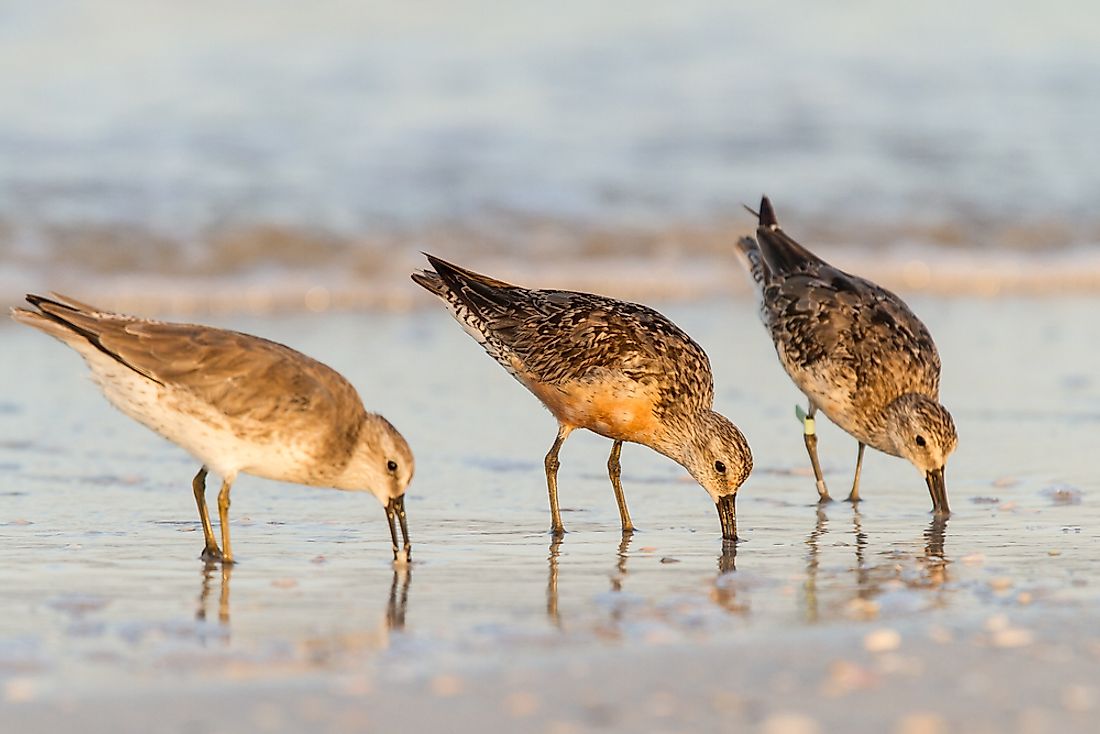The Red Knot Bird - Birds Of The Arctic

5. Physical Description
The red knot, a bird of the tundra and Arctic Cordillera, is fast disappearing from the face of the Earth, its existence being threatened by irresponsible human activities and resultant climate change. The red knot is a small bird, with an average size of about 23 to 26 centimeters, and a wingspan of around 47 to 53 centimeters. The birds are dull colored in winter, bearing a grayish plumage, while during the breeding season they grow a mottled plumage on the dorsal surface and a cinnamon-colored face and undersides. The birds have small heads and eyes, and a short, tapered, and dark-colored beak.
4. Diet and Behavior
The red knots have a varied diet, feeding on both plant parts like leaves, fruits, and seeds as well as animals like crustaceans, mollusks, insects, and other invertebrates. During the migratory season, the birds feed on the aquatic invertebrates in the intertidal zones. Prior to the breeding seasons, they mostly depend on a plant based diet as insects are rare at that time while during the breeding season, they mostly feed on flies and other insects. The red knots use their sense of sight to detect their food in the tundra breeding sites as well as on sandy sea beaches. However, in the case of muddy beaches, the birds dig into the ground with their beak to detect food.
3. Habitat and Range
In summer, the red knots inhabit the high, bare landscape of the Arctic tundra while in winter, they migrate down south towards coastal areas with muddy flats or sandy beaches. The birds are found in the Arctic and tundra zones of Canada, Russia, and Europe in summer. The North American populations migrate to coastal areas of South America and southern Europe in summer while the populations from Eurasia migrate towards the coasts of Africa and Oceania in winter.
2. Threats and Conservation
Recent observations by scientists have triggered a wave of concern among the conservationists and bird lovers about the fate of the red knots. In the mid-Atlantic coasts that fall within the summer migration range of these birds, horseshoe crab populations and their eggs are rapidly declining in numbers due to over harvesting. The eggs of these crabs, being one of the primary sources of food for the red knots, is thus leading to a major food crisis for the red knots. The rising sea levels also threaten the winter migratory habitat of the red knots. The red knot population migrating to South America have declined by nearly 50% between the 1980’s and 2003. The International Union for the Conservation of Nature (IUCN) has also classified these birds as "Near Threatened". The decimation of the red knot population is just the tip of the iceberg. It reveals how the entire aquatic and terrestrial food chains are being adversely affected by climate change and over-harvesting of natural resources by humans.
1. Reproduction and Life Cycle
The red knots are known to be seasonally monogamous, meaning that they mate with only a single partner during one breeding season. The male birds exhibit territoriality, fiercely defending their nests from other males. After mating is over, the birds nest on the ground where the female lays 3-4 eggs over a course of 6 days. Both the parents then take their turns at incubating the eggs. After about 22 days, the eggs hatch and the chicks that emerge soon start accompanying their parents on their foraging ventures. The male usually leaves the nest but the female stays on with her chicks until they learn to fledge (develop the physical abilities and musculature needed to fly). Soon, the chicks become completely independent, and start migrating to the summer destinations on their own.











